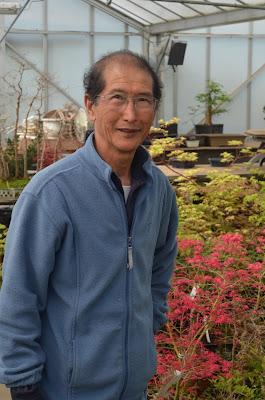 |
| The secrets to growing bonsai |
All photographs are reproduced with the kind permission of Peter Chan
If you want to know how to grow bonsai then you really can't do better than to ask Peter Chan, owner of Britain's premier Bonsai nursery - Herons Bonsai.
Peter Chan is the author of eight books on the subject and a winner of no less that 21 Chelsea Flower Show Gold Medals (a feat that no other bonsai specialist has managed to achieve). I doubt that there is anything that Peter Chan doesn't know about his specialized subject .
 |
| Petre Chan |
After deciding to visit Herons Bonsai in order to find a pot the exact shade of blue that the future Mrs. Eade had decided on, I managed to meet up with Peter near his landscaped Japanese 'Stroll garden'.
After introductions, I was blessed with a private tour of the inner workings of the nursery. It was time to glean the secrets of growing bonsai from the best mind in the country.
The first surprise I came across was that all the Acer species of bonsai were produced on site at the nursery making Herons Bonsai completely self sufficient for stock of this family of plants. How does Peter achieve this? Well of course, propagation through seed and cuttings will account for all the small stock, but what about the decent number of larger specimens.
Even though Peter has been producing Bonsai at Herons since 1986, the only realistic way that he could have built up such a large and varied selection of mature specimens would have been by not selling any of them - which is of course ridiculous. So how does he do it?
The first secret
 |
| Air layering on Acers |
Air layering is a propagation technique by where a section of branch is encouraged to break in to adventitious roots.
Adventitious roots are those which arise out of sequence from the more usual root formation, and instead originate from the stem, branches, leaves, or old woody roots.
Air layering is executed by wounding a section the stem with a sterilised blade where the roots are required to form. If necessary, a dusting of rooting hormone powder can be applied to these wounds in order to encourage the adventitious roots to initiate.
 |
| Air layering on hornbeam |
Pack the wrapping sleeve with a moist rooting medium to a thickness of 3-4 inches. The rooting medium is then secured in place using clear plastic.
The rooting medium should always provide aeration and a constant supply of moisture. Peter Chan prefers to use sphagnum moss.
Leave the wrapping in place for up to a year, and check it occasionally for signs of rooting.
When strong new roots are visible through the moss, remove the plastic sleeve. Cut through the stem just below the rooted section
Once sufficient root has been produced, a cut can be made below the adventitious roots, and this new plant can be potted on until it is large enough to plant outside
By carefully selecting interesting branch formations Peter Chan is able to produce the foundation of a new specimen in a traditional bonsai style.
This saves years on trying to produce stock by seed or cuttings, plus you have the advantage of an instant, mature plant.
Peter Chan also uses this technique on hornbeam, and on rare occasions beech.
The second secret
 |
| Carpinus species growing in sphagnum moss |
Instead, these bonsai's are potted on into a medium made up entirely of sphagnum moss - which is of course sterile.
Therefore, all the plants nutrients are supplied using a liquid feed and these bonsai's will remain in sphagnum moss for up to two years before being potted on to a more commercial compost mix.
The third secret
 |
| Copper wire embedded in pine |
They will also remove or replace them as the plants branches increase in size.
Peter Chan's method is leave the wire in place and allow the trees bark to grow and callous over the wires forming a pleasing, gnarled effect.
Just be aware that there are no shortcuts to this effect, and you can expect it to take a number of years to come to fruition.
The fourth secret
The root balls of bonsai are deliberately cropped in order to induce the environmental stress that helps the 'miniaturization' of the plant.
 |
| Peter Chan, the future Mrs. Eade and baby George |
With this in mind you will probably find that during the growing season your bonsai will need watering almost every day, and during the peak of summer this will probably need to increase to twice a day. You may wish to move you bonsai to a shaded, sheltered area under these circumstances to reduce the risk of drying out.
Underestimating this will result in leaf drop as your bonsai reacts to environmental shock. Of course try not to make things worse by leaving you bonsai in a bucket of water for a few days to compensate as this will quickly kill off what was left of your bonsai root system.
Of course, there is so much more to learn from Peter Chan than time would allow. However, you can find out more by reading his best selling book:
Bonsai Secrets: Designing, Growing And Caring for Your Miniature Masterpieces
If you would like to find out more about Peter Chan and Heron Bonsai then you can visit his website from this link - http://www.herons.co.uk/
For related articles click onto:
HOW TO GROW JAPANESE MAPLES
HOW TO GROW JAPANESE MAPLES FROM SEED
HOW TO PROPAGATE SHRUBS BY LAYERING
The Secrets to Growing Bonsai
What is Air Layering?







No comments:
Post a Comment